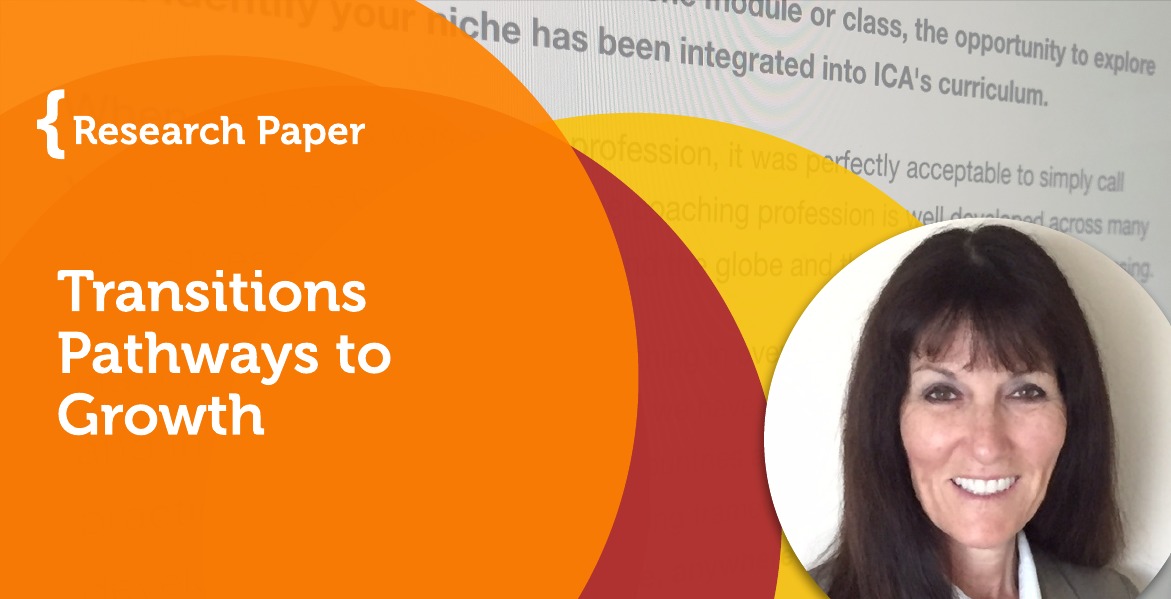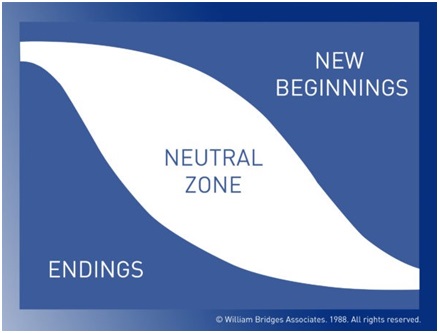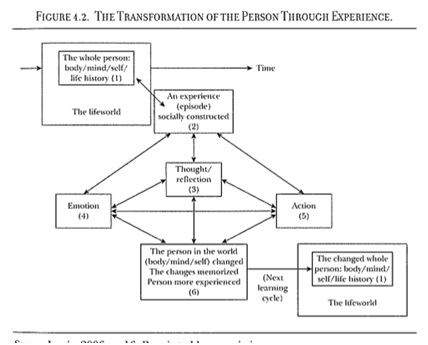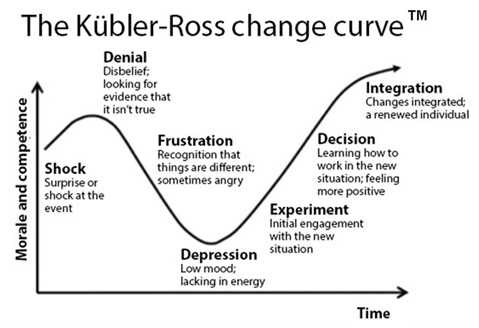 Research Paper By Wendy Leggett
Research Paper By Wendy Leggett
(Business Coach, UNITED STATES)
Not in his goals but in his transitions man is great. –Ralph Waldo Emerson
Our lives are a series of transitions. We will face many of them; statistics indicate that just looking at jobs alone, the average person will make changes 10-12 times during their career. Yet, often we experience transitions with emotions ranging from fear, uncertainty, or at the very least, a lack of awareness about the possibility and promise they hold. By exploring what transitions are, their impact, and how we can successfully navigate them, the process can be better understood, embraced, and maximized. Further, there can be additional support provided to pave the way to enhanced insight and growth in the coaching space.
Speaking personally, I never realized there was much beneath the surface of transitions. I subscribed to the notion that most transitions fall into the category of positive (for myself, this included marriage, new jobs, new houses, babies) or negative (death, move[as a child], kids growing up and away [bittersweet!]) Early on, I read about and adopted the idea that I could rate the life events I experienced on a pre-determined scale. Furthermore, some events received a higher number than others, e.g., Marriage (50) Life Change Units (LCU), Pregnancy (40), Changing to a different line of work (36), Outstanding Personal Achievement (28) based on the amount of stress the change caused the individual. I understood that if I experienced too many changes quickly, e.g., move, have a baby, and get a new job, and I might be overloaded, so I better “prepare” for a rougher road or try to “avoid” something! (I now know this was The Holmes and Rahe Stress Scale, a well-known study and tool for measuring stress based on life events experienced in a given year).[1]Regardless, this was pretty much how I viewed, approached, and navigated my transitions, neatly boxing them up as changes in my life, enjoying the “good,” overlooking, or burying the “bad” and pushing on. Over time, patterns emerged (I didn’t see them), and I replayed them as I experienced subsequent transitions. I often experienced misalignment of values but lacked awareness or understanding to take it further than that. Maybe just as important, I didn’t allow much time or space for reflection. I’m brief in my summary here except to say that by not understanding, I missed a critical opportunity at each transition to reassess, reorient, and reflect. I could have released some of the past, been more conscious in my decision-making and commitment to the present, and allowed for additional growth. Instead, I sidestepped many vital points in my mental and emotional journey and missed out on what I now view as higher learning pathways and experiences. Through recent self-discovery, reading, and my training and studies as a Professional Coach, I’ve become more aware of the possibilities when choosing a road that includes exploration, reflection, and action. Additionally, learning more about transitions, in particular, holds special significance for me as it represents critical junctures in our lives and, by understanding their power and potential, I and, in turn, the Clients I support, can choose to make more of those moments.
Transition Defined
It is essential to first distinguish between change, an external event or situation, and transition, which includes the internal shift, the internal psychological process one experiences as they recognize the change’s impact. It is critical that this “inner reorientation and self-definition” occur to facilitate the adaptation of those changes into one’s life so that the transition happens and the changes “take.” [2] The focus may often center on the tangible, the activity, the happening, with little to no consideration given to the person with their feelings, thoughts, and emotions. Here, the past is often not left in the past, and old patterns, beliefs, and more may tag along into the new situation and repeat. Additionally, some may view the transition as a temporary or an accidental disruption in an otherwise stable existence, choosing to bypass the opportunities presented to their development and self-discovery. In the short term, one might appear to make gains; by not spending time on reflection and reorientation, one can quickly move through the process. However, in the long run, one loses the chance to learn more about their inner workings, which serves on greater self-knowledge.
Transition presents a time for learning and growth. Let’s explore:
Perspective
The future is always all around us, waiting, in moments of transitions, to be born in moments of revelation. No one knows the shape of that future or where it will take us. We know only that it is always born in pain. –J.Michael Stracynski
According to Screenwriter Stracynski, it appears that transitions fall on the negative side of the spectrum. For many, this is the case. If one’s identity too closely aligns with their present situation and then a change is made, they may feel too heavily invested to see the possibilities. If someone views the circumstance with fear, uncertainty and, or doubt and doesn’t take time to reflect and dig deeper, they may not fully process the entire picture, avail themselves of support structures and, or rob themselves of other points of view. The same holds for positive changes. If accepted at face value without pause- no review, letting go, and, or reorientation- then important feelings might be overlooked or covered up, misgivings minimized, critical thoughts repressed. In sum, it is a matter of perspective. It’s not about defining a transition as positive or negative, or for that matter, even terming it as a transition. What matters more is how one perceives it. Widely published views in stress and coping literature offer”…no such thing as an inherently difficult life transition. Life events are as stressful, or not, as you make them. It’s all in the mind-set you apply”.[3]It’s important to recognize that our lives have scores of transitions. If we look toward them with positivity, preparation, and purpose, we can hopefully navigate the waters of change to an outcome of growth and forward movement.
Approach
[It’s]… not about conquering a challenge and completing a task but understanding that transition is a constant and unsettling process that offers, as all great hero’s journeys do, the chance of growth and redemption. –Michael Bungay Stanier, author of The Coaching Habit
Numerous models map out the advised path to take at a point of transition; several are highlighted below. Common to all: a shared belief that transition provides an opportunity to learn and grow; a time to reflect is needed, and although we see external changes, internal work is/should also be taking place.
What we call the beginning is often the end And to make an end is to make a beginning. The end is where we start from. –T.S. Eliot
The Bridges model opened the door to the idea that beginning anew must start with an ending. Over 40 years ago, William Bridges shared a concept that is still widely endorsed today: all transitions go through 3 phases (Beginning, Neutral Zone, and Ending), and the 1st phase is an Ending. Until then, he saw that transitions were approached with a beginning and an ending, and nothing much else. He felt this was unintelligible and frightening to people. By recognizing that, to make, effective and lasting change, the first step will be ending something, Bridges felt real opportunities could emerge. This starting with an ending would allow the individual to focus on going through whatever emotions surface. These may include anger, shock, denial, fear, or sadness. Acknowledging, accepting, and giving space for these reactions provides the space to release resistance to the change and let go. The next phase is one of reflection and reorientation (Neutral Zone). It can be a time of skepticism, confusion, apathy, and frustration, and also thoughtfulness, introspection, and creativity. Given time the individual will emerge into the final phase, The New Beginning.
This model can provide insights when we explore, for ourselves or with our clients, anticipated and past transitions that have occurred. We may discover that Endings and, or Neutral Zones have importance before moving into a New Beginning when previous transitions occurred. There may be patterns, underlying beliefs, perspectives, etc.carried forward into the present that don’t serve us. Recognizing that this may be a factor contributing to repeated patterns or stuck feelings and exploring what changes are possible may open-up doors of possibilities toward future growth. We will experience so many transitions during our lives; we must recognize and anticipate this alternating experience of expansion and contraction, change, and stability. Using transition points for reflection, release, and reorientation, and the resulting opportunity for growth and development will provide a lifetime of benefit. [4]
[4]
The Jarvis Experiential Learning Modelsees transition as a disquiet time and disequilibrium that requires attention and reflection. Jarvis’research spotlights the impact transition has on the stability in an individual’s life from the emotional, cognitive, and social aspects. He observed transitions“jar us out of our taken-for-granted worldviews and prompts us to seek new information and explanatory models to understand the experience and thus stimulates learning.” He terms these occurrences as “disjunctures,” and his model highlights that the whole person- body, mind, and self will be affected. A search will ensue for answers to right this out-of-balance state, and the resultant shifts that take place will be both internal and external.
 [5] Jarvis Experiential Learning Model
[5] Jarvis Experiential Learning Model
Ibarra and Obodaru, in their research on transitions, underscore the importance of allowing oneself to embrace the period of uncertainty, as painful as it may be (Bridge’s Neutral Zone), and not force it to a quick close. They, like the others, discovered that “Tolerating painful discrepancies and allowing time for self-exploration and self-testing is crucial to expanding your sense of purpose and identity”[6]It’s important to note this can occur in any transition, whether viewed as a “positive” or “negative” event. The self-reflection, learning, and growth opportunities are all still available, applicable, and relevant. It’s unfortunate when we don’t avail ourselves of these precious passages either because of conditioning, perceived time constraints, buried feelings, fixed mindsets, or the like.
Going beyond the cognitive and delving specifically into the emotional aspects of transitions is research by, among others, Hopson and Adams. They focused on the visual and definitive impact of self-esteem. They posited that any transition, regardless of its origin, sets into motion a cycle of changes specifically to self-esteem. Further, for a satisfactory outcome, one must work through this set of reactions (not everyone experiences all stages); some individuals remain in some stages longer than others).[7]
 Hopson and Adams Transition Cycle – a template for human responses to change
Hopson and Adams Transition Cycle – a template for human responses to change
Also, in this area of emotions is the work of Kübler-Ross. A step beyond her well-known 5 Stages of Grief is her Change Curve, which lines up effectively with Bridges Transition Model. By overlaying Kübler-Ross’s model, we have a roadmap informing us how an individual may be feeling during the various transition stages. In this way, we can see how Bridge’s Phase I: Ending, may line up with Kübler-Ross’s Shock & Denial; Phase II: Neutral Zone, with Frustration & Depression moving into Experiment which flows to Phase III: New Beginning, Decision & Integration. (Note: The feelings and the stages aren’t necessarily linear; also, experiences will be at different degrees.)
Summary
There are numerous transition models and scores of related situations based on demographics, context, time of life, etc.; I’ve presented a few for consideration. Of significance to me is that there is structure, in-depth research, and verifiable science behind this point of the passage. I’ve highlighted findings that shine a light on the importance of looking at the whole individual, recognizing external and internal impacts, cognitive and emotional implications, and that perception plays a vital role. Realizing the treasure held in transitions through this awareness of their depth and promise brings excellent gains. The key to all transitions is going beyond/digging deeper than the visual, external change. I have learned that transitions present an opening to, among other things, reassessing, letting go, self-reflecting, and consciously committing toa new or altered path. If the opportunity is recognized and seized, transitions can be a time of inner shifts, growth, and learning. Perspective also plays an important role, perceiving the transition as a potential for growth and choosing to embark on that path. Being aware that an opportunity is at hand and seizing it is a critical 1st step.
Personal Reflections
Coaching Application
Story
Tanzan and Ekido were once traveling- together down a muddy road. Heavy rain was still falling. Coming around a bend, they met a lovely girl in a silk kimono and sash, unable to cross the intersection. “Come on, girl,” said Tanzan at once. Lifting her in his arms, he carried her over the mud. Ekido did not speak again until that night when they reached a lodging temple. Then he no longer could restrain himself. “We monks don’t go near females,” he told Tanzan, “especially not young and lovely ones. It is dangerous. Why did you do that?” “I left the girl there,” said Tanzan. “Are you still carrying her?”[9]
In the Coaching Space, our Client may uncover past experiences that are coloring present circumstances or future opportunities. They may discover that they never entirely Ended a transition(s). They have patterns in place, carried over from transition to transition that doesn’t serve them, or view transitions with trepidation or fear. In these and myriad other situations, the Coach can support their Client by, where appropriate, challenging their perspective and offering space for exploration and further growth.
Questions to open the exploration:
Client: I’m going to have a baby; of course, I’m excited! Life won’t be the same, that’s for sure.
Coach: I hear you’re excited, and that life won’t be the same. Having a baby is a time filled with emotions. What else are you feeling?
Client: We’re moving from our home of 20 years. It’s where we raised our kids. There’s so much to do with the packing, prepping for sale, and everything else. I’m focused on getting it all done and looking for a new condo.
Coach: It sounds like you are busy with a lot of logistics. What are your thoughts about moving from your home of 20 years?
Client: This new job is great. I’m enjoying freedom from sales quotas and more balance in my life. But, I do still feel stressed that I’m not doing enough.
Coach: What does doing enough feel like for you?
Exercises
Create a Transition Timeline[10]: Note key events throughout your life. The timeline gives an overview of the positive and negative shifts that have occurred. Reflect on experiences, behaviors, thoughts, learnings, changes that took place – patterns may emerge. What could be explored further for conscious, self-directed changes?
Visualization: Envision the new beginning as if you’re already experiencing it. See what you want to achieve; be committed to and intentional about your plans to bring your vision to reality.
Honor the Transition: In our fast-paced world, we don’t practice as many traditions as in the past. Consider a ceremony, ritual, or private time to signify your transition. This act may facilitate letting go, the building needed support structures, space for self-reflection, etc.
In Conclusion
Light precedes every transition. Whether at the end of a tunnel, through a crack in the door or the flash of an idea, it is always there, heralding a new beginning. –Teresa Tsalaky
As we’ve seen, there are many schools of thought when it comes to embarking upon transition; this paper has hardly scratched the surface. However, what does emerge is that transition presents a pivotal point in time for self-reflection, reorientation, reassessment, and ultimately for growth and learning. While the world may see external changes taking place, the individual who steps into the fullness of the transition can experience the depths and benefits of self-awareness and inner shifts. On one’s own, with the help of a strong support structure or partnering with a Coach, transitions can be another gem-rimmed stepping-stone on the pathway to a purpose-filled life.
Resources
[1]T.H. Holmes& R.H. Rahe (1967).The Social Readjustment Rating Scale.Journal of Psychosomatic Research, 11(2) 213-221
[2]William Bridges, Ph.D., Transitions(New York: Hachette 2019)xiii
[3]Susan Whitbourne, “10 Ways to Make it Through Your Life’s Transitions”, Psychology Today, March 14, 2017.
[4]Bridges, Transitions
[5]Sharan Merriam et al., Learning in Adulthood(San Francisco: Jossey-Bass,2007), pp163-169.
[6]H.Ibarra &O. Obodaru, (2016). Betwixt and between identities: Liminal experience in contemporary careers. Research in Organizational Behavior, 36, 47-64
[7] J. Adams, J. Hayes, and B. Hopson: Transition: Understanding and Managing Personal Change. (London: Martin Robertson and Co. 1976)
[8]Elisabeth Kübler-Ross, “The Kübler-Ross Change Curve,” Elisabeth Kübler-Ross Foundation, accessed August 15, 2020.
[9]Paul Reps (compiled works), “Muddy Road,” Zen Flesh, Zen Bones. (New York: Anchor Books, 1998)
[10], “Life-line exercise,” EOS Life-Work Themes, EOS Career Services. October 2010
